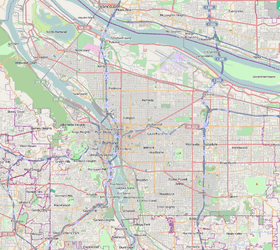Buckman, Portland, Oregon
| Buckman | |
|---|---|
| Neighborhood | |
 Buckman | |
|
Coordinates: 45°31′05″N 122°39′13″W / 45.51792°N 122.65364°WCoordinates: 45°31′05″N 122°39′13″W / 45.51792°N 122.65364°W PDF map | |
| Country | United States |
| State | Oregon |
| City | Portland |
| Government | |
| • Association | Buckman Community Association |
| • Coalition | Southeast Uplift Neighborhood Program |
| Area | |
| • Total | 1.15 sq mi (2.99 km2) |
| Population (2000)[1] | |
| • Total | 7,923 |
| • Density | 6,900/sq mi (2,650/km2) |
| Housing[1] | |
| • No. of households | 4312 |
| • Occupancy rate | 94% occupied |
| • % households renting | 84% renting |
| • Avg. household size | 1.84 persons |
Buckman is a neighborhood in the Southeast section (and a small portion of the Northeast section) of Portland, Oregon. The neighborhood is bounded by the Willamette River on the west, E Burnside St. on the north (except for a triangle between NE 12th Ave. and NE 14th Ave. in which NE Sandy Blvd. forms the northern border), SE 28th Ave. on the east, and SE Hawthorne Blvd. on the south.
Schools in the neighborhood include Buckman Arts Magnet Elementary School (part of Portland Public Schools) and Central Catholic High School.
The neighborhood is named for late 19th century orchardist, and school board and city council member, Cyrus Buckman. In the 19th Century the neighborhood was the center of the City of East Portland before it merged with the City of Portland on the west bank of the Willamette River. Today, the historic center of East Portland is designated as the East Portland Grand Avenue Historic District. The former Washington High School, built in 1924, is also in Buckman.
Three bridges connect Buckman to neighborhoods in Southwest Portland across the Willamette: the Old Town Chinatown neighborhood via the Burnside Bridge, and Downtown Portland via the Morrison and Hawthorne Bridges.
Two retail districts lie partially within Buckman: the Belmont District and the Hawthorne District.
The neighborhood also includes Lone Fir Cemetery (1855), Colonel Summers Park (1921), Buckman Community Garden (1980), and much of the Vera Katz Eastbank Esplanade (opened 2001).
See also
References
External links
- Central Eastside Industrial Council
- Belmont Area Business Association (BABA)
- Hawthorne Boulevard Business Association
- Guide to Buckman Neighborhood (PortlandNeighborhood.com)
- Buckman neighborhood and community information
- Buckman Community Association
- Buckman Historic Association